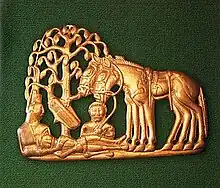.png.webp)  -500 ◁ ▷ Location of the Sargat culture, with contemporary cultures in the 5th century BCE | |
| Geographical range | Siberia |
|---|---|
| Dates | 7th century BCE to 5th centuries CE |
| Preceded by | Barkhatovo culture, Itkul culture, Baitovo culture, Gorokhovo culture, Irmen culture |
| Followed by | Bakal culture |
Sargat culture, was a sedentary archaeological culture that existed between 7th century BC and 5th century AD in Western Siberia. Sargat cultural horizon encompassed northern forest steppe zone between the Tobol and Irtysh rivers, which is currently located in Russia and Kazakhstan.[1] The northernmost Sargat culture presence is found near Tobolsk, on the border of the forest zone. In the south, the area of culture coincides with the southern border of the forest-steppe. Eastern foothills of the Urals make up the western boundary of the culture, meanwhile Baraba forest-steppe forms the eastern edge for Sargat settlements and burial grounds. The culture is named after the village of Sargatskoye, which is located near a Sargat burial ground.
Archeological and genetic evidence suggest that Sargat culture was a potential zone of intermixture between native Ugrian and/or Siberian populations and steppe peoples from the south, possibly of early Iranian or Indo-Iranian stock.[2] However, if the Iranians gave the language, it does not explain the origin of the Magyar language.
Society
Metallurgy

Sargat metallurgy shows a domestic character. The remains of simple blast furnaces and forges have been discovered in some settlements associated with the culture. The increasing production of Sargat iron supplied the local population and its nomadic neighbors. Metallographic examination of Sargat material shows that objects made of malleable iron and steel of average and high quality were prevalent. Unevenly carbonized steel was produced directly in the blast furnace. On average, carbonized steel resulted from a special process of cementation was used for weapon production. Forging, multilayered welding, and tempering was known as well, though quality of welding was not high and the temperature regime was rather unstable.[1]
Genetics
mt-DNA samples isolated from individuals associated with the Sargat culture showed that A, C, T1, Z, B4a, N1a1a1a, U5a1, H, H8, and C4a2c1 haplogroups were present among the population. N1a1, R1a1, Q1 and R1b are the Y-chromosomal haplogroups that were isolated from Sargat remains.[2][3]
According to a 2021 study that examined genome-wide data of various ancient Central Asian steppe peoples, the northern sedentary Sargat-related cultures show a close genetic proximity with the eastern nomadic Scythians, the Sakas. The examined Sargat individuals also display additional affinity not found in the Scythian groups, ultimately related to a northern Siberian lineage. They represent a typical Saka combination of Khövsgöl and Steppe_MLBA ancestry with a small BMAC contribution, and a small specific Siberian contribution (Ekven IA).[4] The results affirms the historical hypothesis that the Sargat culture formed as a result of admixture between incoming Scythian groups and an unknown local or neighboring population that possibly carried this extra Siberian ancestry.[4]
 Map of Kulay (orange) and Sargat cultures (green).
Map of Kulay (orange) and Sargat cultures (green)..jpg.webp) Sargat culture individuals (forensic reconstruction)
Sargat culture individuals (forensic reconstruction).JPG.webp) Kurgan Krasnogorsky-2 (Ingala Valley). Sargat culture
Kurgan Krasnogorsky-2 (Ingala Valley). Sargat culture Object of the Siberian Collection of Peter the Great, sent by M. P. Gagarin, governor of Siberia in Tobolsk, in 1716. Dated to the 7th century BCE. State Hermitage Museum, Si 1727 1-88.[5]
Object of the Siberian Collection of Peter the Great, sent by M. P. Gagarin, governor of Siberia in Tobolsk, in 1716. Dated to the 7th century BCE. State Hermitage Museum, Si 1727 1-88.[5] Belt plaque from the Siberian collection of Peter the Great, sent by M. P. Gagarin, governor of Siberia in Tobolsk, in 1716. Dated circa 300 BCE. State Hermitage Museum, Si 1727 1-162.[6]
Belt plaque from the Siberian collection of Peter the Great, sent by M. P. Gagarin, governor of Siberia in Tobolsk, in 1716. Dated circa 300 BCE. State Hermitage Museum, Si 1727 1-162.[6] Watercolour drawing of a contest between tiger and monster from the 1730s, Siberian Collection of Peter the Great. Object sent by M. P. Gagarin, governor of Siberia in Tobolsk, in 1716. Dated circa 300 BCE. State Hermitage Museum, Si 1727 1-11.[7]
Watercolour drawing of a contest between tiger and monster from the 1730s, Siberian Collection of Peter the Great. Object sent by M. P. Gagarin, governor of Siberia in Tobolsk, in 1716. Dated circa 300 BCE. State Hermitage Museum, Si 1727 1-11.[7]
 Coat of arm of the Sargat region
Coat of arm of the Sargat region
See also
References
- 1 2 Koryakova, Ludmila; Epimakhov, Andrej (2007). The Urals and Western Siberia in the Bronze and Iron Ages. Cambridge: Cambridge University Press. doi:10.1017/cbo9780511618451. ISBN 978-0-511-61845-1.
- 1 2 Bennett, Casey C.; Kaestle, Frederika A. (April 2010). "Investigation of Ancient DNA from Western Siberia and the Sargat Culture". Human Biology. 82 (2): 143–156. doi:10.3378/027.082.0202. ISSN 0018-7143. PMID 20649397. S2CID 54566651.
- ↑ Pilipenko, A. S.; Cherdantsev, S. V.; Trapezov, R. O.; Molodin, V. I.; Kobeleva, L. S.; Pozdnyakov, D. V.; Polosmak, N. V. (2017-01-01). "Kinship Analysis of Human Remains from the Sargat Mounds, Baraba Forest-Steppe, Western Siberia". Archaeology, Ethnology & Anthropology of Eurasia. 45 (4): 132–142. doi:10.17746/1563-0110.2017.45.4.132-142. ISSN 1563-0110.
- 1 2 3 Gnecchi-Ruscone, Guido Alberto; Khussainova, Elmira; Kahbatkyzy, Nurzhibek; Musralina, Lyazzat; Spyrou, Maria A.; Bianco, Raffaela A.; Radzeviciute, Rita; Martins, Nuno Filipe Gomes; Freund, Caecilia; Iksan, Olzhas; Garshin, Alexander (2021-03-01). "Ancient genomic time transect from the Central Asian Steppe unravels the history of the Scythians". Science Advances. 7 (13): eabe4414. doi:10.1126/sciadv.abe4414. ISSN 2375-2548. PMC 7997506. PMID 33771866.
- ↑ Pankova, Svetlana; Simpson, St John (1 January 2017). Scythians: warriors of ancient Siberia. British Museum. p. 58, item 16.
- ↑ Pankova, Svetlana; Simpson, St John (1 January 2017). Scythians: warriors of ancient Siberia. British Museum. p. 57, item 15.
- ↑ Pankova, Svetlana; Simpson, St John (1 January 2017). Scythians: warriors of ancient Siberia. British Museum. p. 58, Item 17.